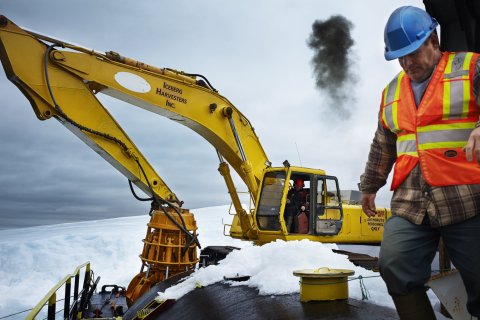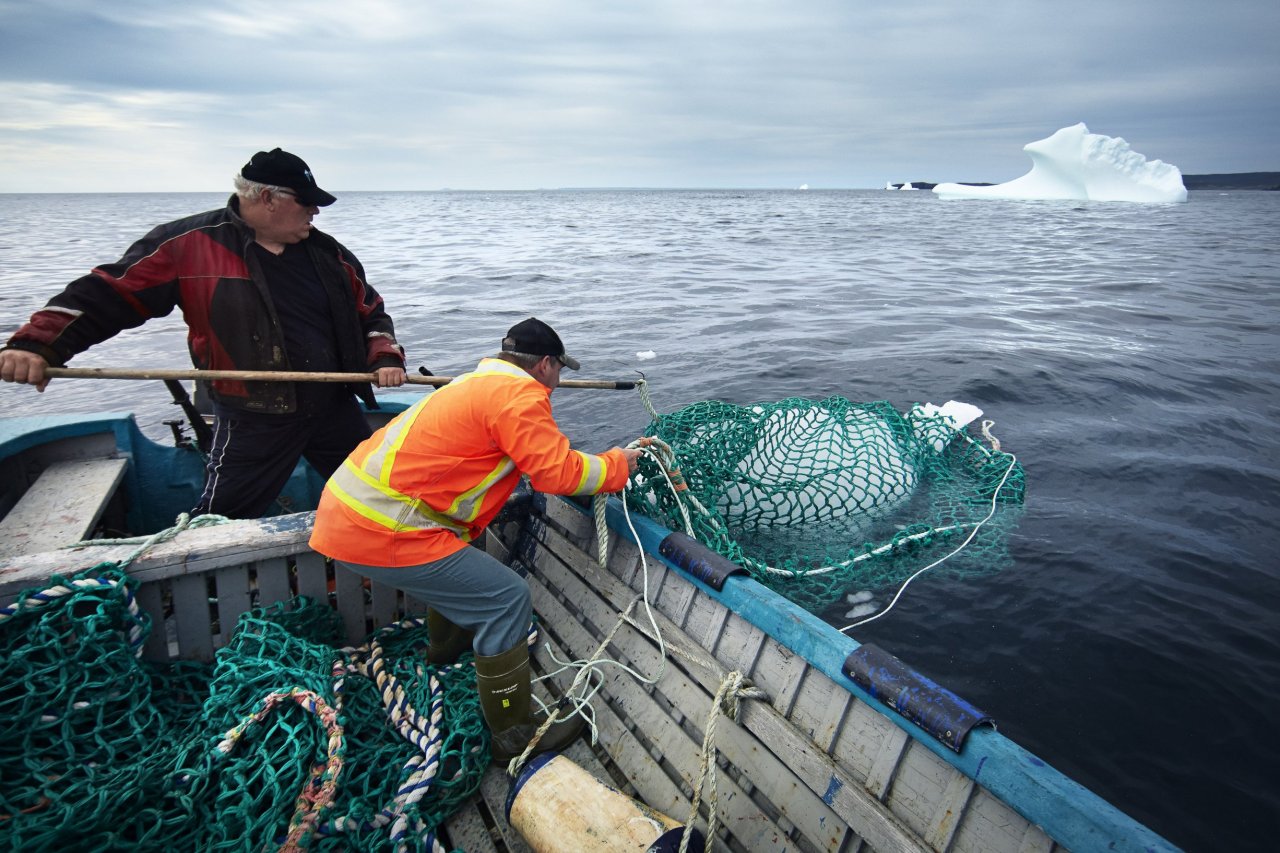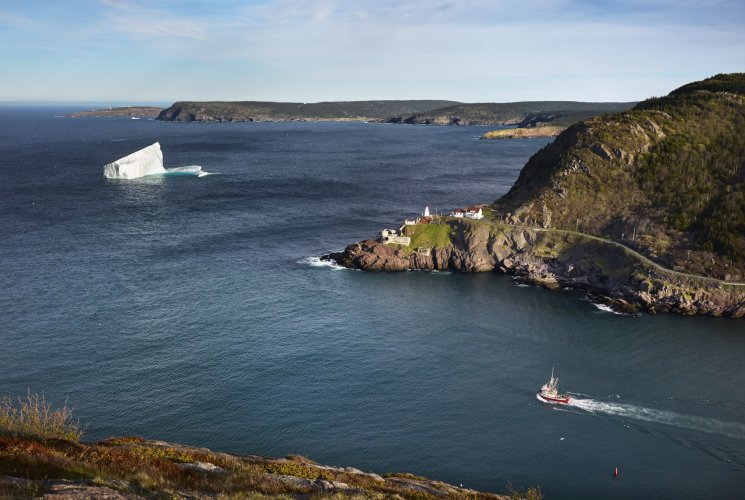Icebergs have many ways to kill a man. They can suddenly roll over, bust apart without warning and hide, invisible in the dark, and then sink unsinkable ships. They're volatile, dangerous and often larger than anything man has built. But they apparently make great vodka.
I think about the Titanic as I sip a thimble of Iceberg brand vodka, poured from a bottle with a blue-and-white rendering of its namesake on the label. Vodka is about 40 percent alcohol and 60 percent water, so over half the bottle in front of me is water plucked from an iceberg. Water that fell as snow tens of thousands of years ago—long before the Industrial Revolution and long before the industrial pollution that now swirls in the air nearly everywhere. I'm not a vodka person, but this one seems smoother than most. I'm not sure if that assessment is coming from my palate or from my romantic mind, which very much likes the idea of drinking something made from ancient water stored in massive, heartbreakingly majestic icebergs.
I'm not the only one smitten by these monoliths. In Newfoundland, whence the iceberg water for my vodka came, iceberg tours are big business, while iceberg water itself, in plain bottled form and for use in high-end vodka, is a small but growing industry. Canadian Iceberg Vodka Corp. produces around 200,000 cases a year, up from the few thousand cases 20 years ago, says President and CEO David Meyers. Typically, bottling companies measure impurities in water in units of parts per million. "We measure impurities in parts per quadrillion," he says proudly, adding that iceberg water is about 10 times less acidic than regular bottled water, leading to its smoothness. But at the end of the day, he says it's "the story that attracts people to the brand."
That story is, in many ways, of the iceberg hunters who've become the modern-day cowboys of the North and South Poles, with reality shows and news articles documenting the unique art of lopping off pieces of massive ice mountains that will be crushed into luxury water.
Humans have been drawing up fantastical plans to wrangle icebergs and subdue them for our use since at least the mid-1800s, when entrepreneurs announced their intention to drag icebergs to India, where the ice could reportedly fetch 6 cents a pound, and to "the southern ocean, for the purpose of equalising the temperature of the earth." In the mid-1970s, scientists from 18 countries gathered at a conference in Ames, Iowa, to contemplate how to tow icebergs to the Arabian Peninsula and other arid regions to be used as a water supply. It never happened, because the technology at the time couldn't manage the tricky feat in a financially feasible way, but scientists are still examining similar plots today. For now, though, it's all still a techno-fantasy.
But what Ed Kean, iceberg hunter, does every day is no dream. He's one of a clutch of men making a living chasing icebergs at the top of the world with a grappling arm and plenty of caution.
"Imagine a time when the earth was pure. And imagine a time, tens of thousands of years ago, when all of earth's water was original, untouched, and absolutely perfect. Imagine water absorbed by the clean atmosphere, and then falling as snow," reads copy for Glace Iceberg Water, one bottled-water company that Kean sells his bounty to each year. Indeed, these icebergs are between 10,000 and 25,000 years old. They're chunks of ice cracked off from the Petermann Glacier on the massive Greenland ice sheet, the product of many years of falling snow compacting and moving, thanks to gravity, toward the sheet's edges. Eventually, the ice breaks off into huge pieces roughly 250 million tons each. That's the equivalent of 1,000 skyscrapers, or the weight of all the trash Americans produce in a year. These icebergs travel between three and five years to their final destination, first flowing south, then slingshotting north with the currents to Baffin Bay, off the southwest coast of Greenland, and then again flowing south, to Newfoundland, where they settle into what's called "iceberg alley."
Anywhere from between three to 600 icebergs make their way through iceberg alley each spring, growing smaller and smaller from April through mid-July until finally melting away completely by late summer off the coast of St. John's, Newfoundland's quaint seaside capital. Just before that happens, Kean makes his harvest. This year, Kean says he saw a bumper crop of 'bergs, far more than normal—he thinks global warming might be a factor but is reluctant to lay all the blame there, due to variations from season to season that he's seen. Climate change has certainly brought more attention to his trade, he says, noting that "more than 30" camera crews have come to record his unique workday over the past few seasons.
Kean has a permit to harvest icebergs from Newfoundland, much like one might have a permit to hunt or fish. He works with a small crew on a 180-foot barge, outfitted with a grappling arm that bites off enough ice with each chomp to yield 1,000 liters of water. All told, Kean and his shipmates harvest about 1,000 tons of ice per year, which crushes down to between 264,000 and 343,000 million gallons of water. Next to a full iceberg, which can be anywhere between 100 million and 250 million tons, that's a drop in the ice bucket.

Newfoundlanders like to say they get their life from the sea. They are a marine people, living on a rock of an island off Canada's Atlantic Coast and surviving on the fishing industry there—until the early 1990s, when the island's centuries-old cod fishery collapsed, immediately putting 40,000 people out of work. They've since had to find other means. Kean was one of them. "I've been around icebergs since I was big enough to work," he says. He remembers hauling slabs of iceberg onboard to keep his catch of cod, Atlantic salmon and Arctic char cold for export. After the collapse, Kean first turned to monitoring icebergs for local university researchers, helping gather the data they used to try to predict the path of the 'bergs. Then came the vodka and bottled-water companies.
It can take weeks for Kean's team to find the ideal 'berg to bite. They have to be careful: If the visible part of the iceberg is around 10 or 15 cars' worth of mass, they can expect another 100 cars below the surface. If that iceberg "rolls"—flips over—the results could be disastrous. "They could sink your boat, sink your barge and sink the Titanic," Kean says, laughing. "We've had a few close or dangerous scenarios.… The iceberg battle is unique." Véronique de Viguerie, a French photojournalist who spent 10 days on Kean's vessel taking the photos that accompany this story, heard a thing or two about those near misses. In 2013, the crew said, an iceberg flipped unexpectedly, causing a small tsunami that came close to inundating the ship, she says. As de Viguerie accompanied them on the hunt, she heard them speculate on the safety of each piece of ice. "She looks dangerous. She can sleep," she heard them say, referring to the icebergs always with female pronouns.
The team has learned to avoid icebergs that have "legs," the curious limb-like protrusions, like massive ice tentacles, that sometimes appear above water as the iceberg melts. These can give the floating 'bergs a less stable center of gravity and make them more likely to roll.
Watching Kean and his team pull massive, ancient hunks of ice through channels lined by the sparse, rolling Newfoundland coast, it's easy to imagine the world it fell on (as snow) tens of thousands of years ago. In a way, iceberg hunters are archaeologists, unearthing these ancient water molecules. But Kean is less sentimental. "It's just frozen snow. Just compacted snow," he says. For him, it's just a job, a way in Newfoundland to still live off the sea. Besides, he says, "they're just going to melt anyway." When the sea gives you ice, you might as well drink it.






















